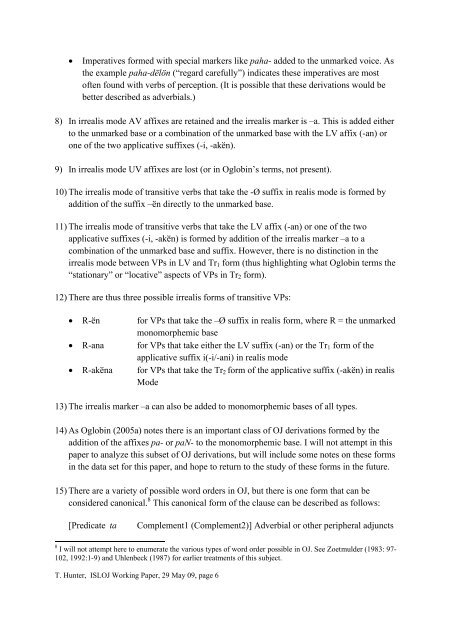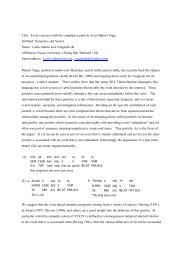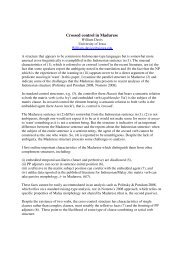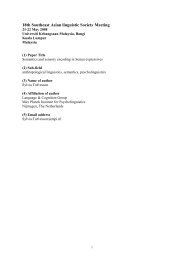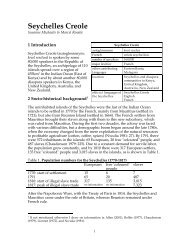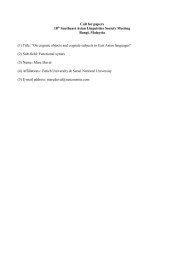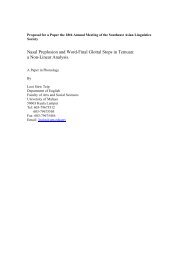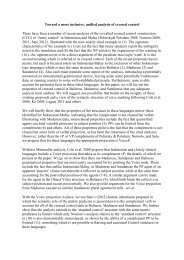Working Paper on Irrealis, Imperative Mode and Complementation ...
Working Paper on Irrealis, Imperative Mode and Complementation ...
Working Paper on Irrealis, Imperative Mode and Complementation ...
Create successful ePaper yourself
Turn your PDF publications into a flip-book with our unique Google optimized e-Paper software.
<strong>Imperative</strong>s formed with special markers like paha- added to the unmarked voice. As<br />
the example paha-dӗlön (“regard carefully”) indicates these imperatives are most<br />
often found with verbs of percepti<strong>on</strong>. (It is possible that these derivati<strong>on</strong>s would be<br />
better described as adverbials.)<br />
8) In irrealis mode AV affixes are retained <strong>and</strong> the irrealis marker is –a. This is added either<br />
to the unmarked base or a combinati<strong>on</strong> of the unmarked base with the LV affix (-an) or<br />
<strong>on</strong>e of the two applicative suffixes (-i, -akӗn).<br />
9) In irrealis mode UV affixes are lost (or in Oglobin’s terms, not present).<br />
10) The irrealis mode of transitive verbs that take the -Ø suffix in realis mode is formed by<br />
additi<strong>on</strong> of the suffix –ӗn directly to the unmarked base.<br />
11) The irrealis mode of transitive verbs that take the LV affix (-an) or <strong>on</strong>e of the two<br />
applicative suffixes (-i, -akӗn) is formed by additi<strong>on</strong> of the irrealis marker –a to a<br />
combinati<strong>on</strong> of the unmarked base <strong>and</strong> suffix. However, there is no distincti<strong>on</strong> in the<br />
irrealis mode between VPs in LV <strong>and</strong> Tr1 form (thus highlighting what Oglobin terms the<br />
“stati<strong>on</strong>ary” or “locative” aspects of VPs in Tr2 form).<br />
12) There are thus three possible irrealis forms of transitive VPs:<br />
R-ӗn for VPs that take the –Ø suffix in realis form, where R = the unmarked<br />
m<strong>on</strong>omorphemic base<br />
R-ana for VPs that take either the LV suffix (-an) or the Tr1 form of the<br />
applicative suffix i(-i/-ani) in realis mode<br />
R-akӗna for VPs that take the Tr2 form of the applicative suffix (-akӗn) in realis<br />
<strong>Mode</strong><br />
13) The irrealis marker –a can also be added to m<strong>on</strong>omorphemic bases of all types.<br />
14) As Oglobin (2005a) notes there is an important class of OJ derivati<strong>on</strong>s formed by the<br />
additi<strong>on</strong> of the affixes pa- or paN- to the m<strong>on</strong>omorphemic base. I will not attempt in this<br />
paper to analyze this subset of OJ derivati<strong>on</strong>s, but will include some notes <strong>on</strong> these forms<br />
in the data set for this paper, <strong>and</strong> hope to return to the study of these forms in the future.<br />
15) There are a variety of possible word orders in OJ, but there is <strong>on</strong>e form that can be<br />
c<strong>on</strong>sidered can<strong>on</strong>ical. 8 This can<strong>on</strong>ical form of the clause can be described as follows:<br />
[Predicate ta Complement1 (Complement2)] Adverbial or other peripheral adjuncts<br />
8 I will not attempt here to enumerate the various types of word order possible in OJ. See Zoetmulder (1983: 97-<br />
102, 1992:1-9) <strong>and</strong> Uhlenbeck (1987) for earlier treatments of this subject.<br />
T. Hunter, ISLOJ <str<strong>on</strong>g>Working</str<strong>on</strong>g> <str<strong>on</strong>g>Paper</str<strong>on</strong>g>, 29 May 09, page 6


